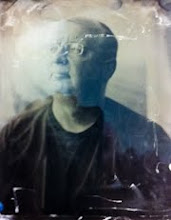Title: "Studio Sink"
(click image to view larger)
Oxidation of metals is a natural process of abstraction. This process of transient states is the fundamental basis of the Japanese aesthetic of wabi sabi. I found myself drawn to this particular subject by the luscious natural colours and tones, the layering of textured surfaces, and the irregular lines formed when layers flake off. There is a richness in that combination that is difficult (but not impossible) to achieve in paintings. But unlike painting, here the process proceeds by the natural laws of physics and chemistry, and there can be no hint of deliberateness in the result. An artist friend, Rhonda Usipiuk, made some metal sculptures under humidified glass enclosures to study and take advantage of this process. Rhonda and I shared an exhibition entitled "Redox" that explored the phenomenon of making art by relying on the changing oxidations states of metals. In my case, that was the oxidation of iron ions in the formation of cyanotype prints, in hers the oxidation of the metals of her sculptures.
Rustarium, Rhonda Usipiuk artist
In response to my musings about the vast gulf that lies between describing a work of art using words, and being able to view the work, my friend JM Golding made the astute observation "...maybe it would make more sense for us to try to describe our responses to art rather than discussing the art itself, since language is one tool we have to express our internal experiences". I agree with this idea completely, it is central to understanding how art works and also to our own growth as artists. There comes a point where simply saying "I really like that", or "I know what I like" limits our understanding of art. Being able to start to move deeper in thinking about what aspects of an art work contribute to its draw upon us greatly enriches the experience. By doing this kind of "critique" of art whenever we are looking at it, we inform ourselves about how different elements of a work contribute to the strong response it invokes in us. This is true equally for both works that we strongly appreciate, and those that leave us cold or uninterested. Doing this deeper thinking on a regular basis educates our eye, and leads naturally to self-critique - applying the same deep thinking to work we make ourselves. Making that part of our art practice is how we as artists continue to improve and helps us make works that have more meaning for ourselves, and others.
P.S. - I just saw this quote someone posted from Rainer Maria Rilke "Understanding is attainable least of all by critique." How ironic, given what I wrote above. However, I wonder if Rilke is referring to criticism, as in negative feedback. When I write critique, I'm referring to a deeper analysis of an art work, which should be a balanced consideration of what does, and doesn't, work in the piece and is not personally directed at the person who made the piece.
P.S. - I just saw this quote someone posted from Rainer Maria Rilke "Understanding is attainable least of all by critique." How ironic, given what I wrote above. However, I wonder if Rilke is referring to criticism, as in negative feedback. When I write critique, I'm referring to a deeper analysis of an art work, which should be a balanced consideration of what does, and doesn't, work in the piece and is not personally directed at the person who made the piece.



1 comment:
I love the colors and the organic forms in this photo, and also the subtlety of light, the sense of looking into/through many layers of reflection and depth, as if looking into deep water that is more and less clear, more and less reflective, in different places.
Thank you for the link to your exhibition - what a wonderful pairing of different approaches to using oxidation in art. It seems to me that you both joined with nature in creating your works, each in a unique way. There's something about that collaboration with nature in both content and process that creates a feeling of being at home in the world.
I was especially drawn to your "Matrix" pieces, which remind me of quilts. And when I looked at "DNA Lineage," I found myself thinking that the shadows on the wall felt like an analogue to the versions of self that are transmitted genetically - structurally similar, yet individual.
Post a Comment